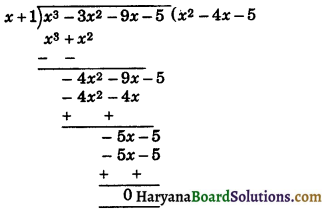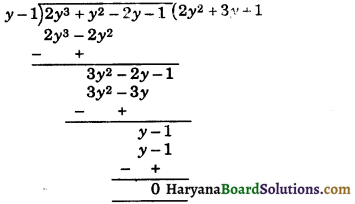Haryana State Board HBSE 9th Class Maths Solutions Chapter 2 Polynomials Ex 2.4 Textbook Exercise Questions and Answers.
Haryana Board 9th Class Maths Solutions Chapter 2 Polynomials Exercise 2.4
Question 1.
Determine which of the following polynomials has (x + 1) as a factor :
(i) x3 + x2 + x + 1
(ii) x4 + x3 + x2 + x + 1,
(iii) x4 + 3x3 + 3x2 + x + 1
(iv) x3 – x2 – (2 + \(\sqrt{2}\))x+ \(\sqrt{2}\).
Solution:
(i) Let
p(x) = x3 + x2 + x + 1
If (x + 1) is a factor of p(x), then by factor theorem, p(-1) should be zero.
Now, p(-1) = (-1) + (-1) – 1 + 1
⇒ p(-1) = – 1 + 1 – 1 + 1
⇒ p(-1) = 2 – 2
⇒ p(-1) = 0.
Hence, (x + 1) is a factor of p(x).
(ii) Let p(x) = x4 + x3 + x2 + x + 1
If (x + 1) is a factor of p(x), then by factor theorem, p(-1) should be zero.
Now, p(-1) = (-1)4 + (-1)3 + (-1)2 – 1 + 1
⇒ p(-1) = 1 – 1 + 1 – 1 + 1
⇒ p(-1) = 1 ≠ 0.
Hence, (x + 1) is not a factor of p(x).
(iii) Let p(x) = x4 + 3x3 + 3x2 + x + 1
If (x + 1) is a factor of p(x), then by factor theorem, p(-1) should be zero.
Now, p(-1) = (-1)4 + 3 × (-1)3 + 3 × (-1)2 – 1 + 1
⇒ p(-1) = 1 – 3 + – 1 + 1
⇒ p(-1) = 1 ≠ 0.
Hence, (x + 1) is not a factor of p(x).
(iv) Let p(x) = x3 – x2 – (2 + \(\sqrt{2}\))x + \(\sqrt{2}\)
If (x + 1) is a factor of p(x), then by factor theorem p(-1) should be zero.
Now, p(-1) = (-1)3 – (- 1)2 – (2 + \(\sqrt{2}\))(-1) + \(\sqrt{2}\)
⇒ p(-1) = – 1 – 1 + 2 + \(\sqrt{2}\) + \(\sqrt{2}\)
⇒ p(-1) = – 2 + 2 + 2\(\sqrt{2}\)
⇒ p(-1) = 2\(\sqrt{2}\) ≠ 0.
Hence, (x + 1) is not a factor of p(x).
![]()
Question 2.
Use the factor theorem to determine, whether g(x) is a factor of p(x) in each of the following cases:
(i) p(x) = 2x3 + x2 – 2x – 1; g(x) = x + 1
(ii) p(x) = x3 + 3x2 + 3x + 1; g(x) = x + 2
(iii) p(x) = x3 – 4x2 + x + 6; g(x) = x – 3.
Solution:
(i) We have,
p(x) = 2x3 + x2 – 2x – 1
If g(x) = x + 1 is a factor of p(x), then by factor theorem, p(-1) should be zero.
Now, p(-1) = 2 × (-1)3 + (-1)2 – 2 × (-1) – 1
⇒ p(-1) = – 2 + 1 + 2 – 1
⇒ p(-1)= 0.
Hence, g(x) = x + 1 is a factor of p(x).
(ii) We have, p(x) = x3 + 3x2 + 3x + 1
If g(x) = 1 + 2 is a factor of p(x), then by factor theorem, p(-2) should be zero.
Now, p(-2) = (-2)3 + 3 × (-2)2 + 3 × (-2) + 1
⇒ p(-2) = – 8 + 12 – 6 + 1
⇒ p(-2) = – 14 + 13
⇒ p(-2) = -1 ≠ 0.
Hence, g(x) = x + 2 is not a factor of p(x).
(iii) We have, p(x)= x3 – 4x3 + x + 6
If g(x) = x – 3 is a factor of p(x), then by factor theorem, p(3) should be zero.
Now, p(3)= (3)3 – 4 × (3)2 + 3 + 6
⇒ p(3) = 27 – 36 + 3 + 6
⇒ p(3) = 36 – 36
⇒ p(3) = 0.
Hence, g(x) = x – 3 is a factor of p(x).
Question 3.
Find the value of k, if x – 1 is a factor of p(x) in each of the following cases :
(i) p(x) = x2 + x + k
(ii) p(x) = 2x2 + kx + \(\sqrt{2}\)
(iii) p(x) = kx2 – \(\sqrt{2}\)x +1
(iv) p(x) = kx2 – 3x + k.
Solution:
(i) We have,
p(x) = x2 + x + k
If (x – 1) is a factor of p(x), then by factor theorem, p(1) should be zero.
⇒ p(1) = 0
⇒ (1)2 + 1 + k = 0
⇒ 1 + 1 + k = 0
⇒ 2 + k = 0
⇒ k = – 2
Hence, k = -2
(ii) We have, p(x) = 2x2 + kx + \(\sqrt{2}\)
If (x – 1) is a factor of p(x), then by factor theorem, p(1) should be zero.
⇒ p(1) = 0
⇒ 2 × (1)2 + k × 1 + \(\sqrt{2}\) = 0
⇒ 2 + k + \(\sqrt{2}\) = 0
⇒ k = – 2 – \(\sqrt{2}\)
⇒ k = -(2 + \(\sqrt{2}\))
Hence, k= – (2 + \(\sqrt{2}\)).
(iii) We have, p(x) = kx2 – \(\sqrt{2}\)x +1
If (x – 1) is a factor of p(x), then by factor theorem, p(1) should be zero.
⇒ p(1) = 0
⇒ k × (1)2 – \(\sqrt{2}\) × 1 + 1 = 0
⇒ k – \(\sqrt{2}\) + 1 = 0
⇒ k = \(\sqrt{2}\) – 1
Hence,
k = \(\sqrt{2}\) – 1
(iv) We have, p(x) = kx2 – 3x + k
If (x – 1) is a factor of p(x), then by factor theorem, p(1) should be zero. =
⇒ P(1) = 0
⇒ k × (1)2 – 3 × 1 + k = 0
⇒ k – 3 + k = 0
⇒ 2k – 3 = 0
⇒ 2k = 3
⇒ k = \(\frac {3}{2}\)
Hence,
k = \(\frac {3}{2}\)
![]()
Question 4.
Factorise:
(i) 12x2 – 7x + 1
(ii) 2x2 + 7x + 3
(iii) 6x2 + 5x – 6
(iv) 3x2 – x – 4.
Solution:
(i) 12x2 – 7x + 1 = 12x2 – (4 + 3)x + 1
= 12x2 – 4x – 3x + 1
= (12x2 – 4x) – (3x – 1)
= 4x(3x – 1) – 1(x – 1)
= (3x – 1) (4x – 1).
Hence, 12x2 – 7x + 1 = (3x – 1) (4x-1).
(ii) 2x2 + 7x + 3 = 2x2 + (6 + 1)x + 3
= 2x2 + 6x + x + 3
= (2x2 + 6x) + (x + 3)
= 2x(x + 3) + 1(x + 3)
= (x + 3) (2x + 1).
Hence, 2x2 + 7x + 3 = (x + 3) (2x + 1).
(iii) 6x2 + 5x – 6 = 6x2 + (9 – 4)x – 6,
= 6x2 + 9x – 4x – 6
= (6x3 + 9x ) -(4x + 6)
= 3x(2x + 3) – 2(2x + 3)
= (2x + 3) (3x – 2).
Hence, 6x2 + 5x – 6 = (2x + 3) (3x – 2).
(iv) 3x2 – x – 4 = 3x2 – (4 – 3)x – 4,
= 3x2 – 4x + 3x – 4
= (3x2 – 4x) + (3x – 4)
= x(3x – 4) + 1(3x – 4)
= (3x – 4) (x + 1).
Hence, 3x2 – x – 4 = (3x – 4)(x + 1).
Question 5.
Factorise :
(i) x3 – 2x2 – x + 2
(ii) x3 – 3x2 – 9x – 5
(iii) x3 + 13x2 + 32x + 20
(iv) 2y3 + y2 – 2y – 1.
Solution:
(i) Let
p(x) = x3 – 2x2 – x + 2
Factors of + 2 are ±1, ±2.
Now, put
x = 1
∴ p(1) = (1)3 – 2 × (1)2 – 1 + 2
= 1 – 2 – 1 + 2 = 0.
∴ By factor theorem, (x – 1) is a factor of p(x). Now, divide x3 – 2x2 – x + 2 by (x – 1), we get

So, x3 – 2x2 – x + 2 = (x – 1)(x2 – x – 2)
= (x – 1)(x2 – (2 – 1)x – 2)
= (x – 1)(x2 – 2x + x – 2)
= (x – 1) [(x2 – 2x) + (x – 2)]
= (x – 1) [x(x – 2) + 1(x – 2)]
= (x – 1)(x – 2)(x + 1).
Hence, x3 – 2x2 – x + 2
= (x – 1) (x – 2) (x + 1).
(ii) Let
p(x) = x3 – 3x2 – 9x – 5
Factors of – 5 are ±1, ±5.
Now, put x = – 1
∴ p(-1)=(-1)3 – 3 × (-1)2 – 9 × (-1) – 5
= – 1 – 3 + 9 – 5
= – 9 + 9 = 0.
∴ By factor theorem, (x + 1) is a factor of p(x). Now, divide x3 – 3x2 – 9x – 5 by (x + 1), we get

So, x3 – 3x2 – 9x – 5= (x + 1) (x2 – 4x – 5)
= (x + 1) (x2 – (5 – 1)x – 5]
= (x + 1) [x2 – 5x + x – 5]
= (x + 1) [(x2 – 5x) + (x – 5)]
= (x + 1) [x(x – 5) + 1(x – 5)]
= (x + 1)(x – 5)(x + 1).
Hence, x3 – 3x2 – 9x – 5
= (x + 1)(x – 5) (x + 1).
(iii) Let p(x) = x3 + 13x2 + 32x + 20
Factors of 20 are = ±1, ±2, ±4, ±5, ±10 and ±20.
Now, put
x = – 1
∴ p(-1) = (-1)3 + 13 × (-1)2 + 32 × (-1) + 20
= – 1 + 13 – 32 + 20
= 33 – 33 = 0.
∴ By factor theorem, (x + 1) is a factor of p(x).
Now divide x3 + 13x2 + 32x + 20 by (x + 1), we get

So, x3 + 13x2 + 32x +20= (x + 1) (x2 + 12x + 20)
= (x + 1) (x2 + (10 + 2)x +20)
= (x + 1) (x2 + 10x + 2x +20)
= (x + 1) [(x2 + 10x) + (2x + 20)]
= (x + 1) [x(x + 10) + 2(x + 10)]
= (x + 1)(x + 10) (x + 2).
Hence, x3 + 13x2 + 32x + 20
= (x + 1) (x + 10) (x + 2).
(iv) Let p(y) = 2y3 + y2 – 2y – 1
Factors of -1 = ±1
Now, put
y = 1
∴ p(1) = 2 × (1)3 + (1)2 – 2 × 1 – 1
= 2 + 1 – 2 – 1
= 3 – 3 = 0
∴ By factor theorem, (y – 1) is a factor of p(y).
Now, divide 2y3 + y2 – 2y – 1 by (y – 1), we get

So, 2y3 + y2 – 2y – 1 = (y – 1) (2y2 + 3y + 1)
= (y – 1) [2y2 + (2 + 1)y + 1] [∵ 2 × 1 = 2, 2 + 1 = 3]
= (y – 1) [(2y2 + 2y) + (y + 1)]
= (y – 1) (2y(y + 1)) + 1(y + 1)]
= (y – 1)(y + 1) (2y + 1)
Hence, 2y3 + y2 – 2y – 1 = (y – 1) (y + 1) (2y + 1).